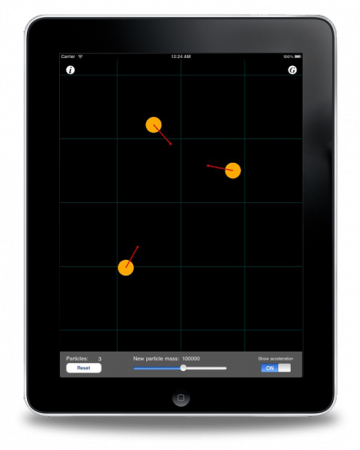Gravity Lab for iPad
Gravity Lab is an iPad gravity simulator. It allows you to create massive bodies on a 2-D plane and set their initial velocities by dragging your finger. Their attraction is then simulated, which causes them to accelerate (and combine) according to Newton’s law of universal gravitation. Newton’s law states that every massive body in the universe attracts every other massive body; such attraction is proportional to masses of both bodies and inversely proportional to the square of the distance between them.
All beings living on Earth’s surface become, through life’s experience, intimately acquainted with the force of gravity. Gravity keeps us from drifting freely into space. Yet there’s something extremely limiting in our perception: the only significant gravitational force that we can perceive is that of the Earth, which has mass approximately 60,000,000,000,000,000,000,000 times greater than an average human being standing on its surface. The gravitational attraction doesn’t feel very mutual (although the forces of attraction of both bodies are equal in size), which is due to the much higher mass and consequently higher inertia of the Earth.
Gravitational force is also the weakest force in nature, either compared to electromagnetic, weak or strong force. Take a look at the comparison here. The strength of the gravitational attraction is for a factor of 1036 (or 1,000,000,000,000,000,000,000,000,000,000,000,000) times weaker than the electromagnetic force (which also works universally — that is, with unlimited range). The value of the gravitational constant G used to calculate the force in the Newton’s equation: F=Gm1m2/r2 is 0.00000000006674, which means the masses have to be extremely large and distances reasonably short for force F to become noticeable.
That’s where a simulator can help. Generating large massive bodies has never been easier. The simulator then calculates and updates the forces between them in real-time and, besides helping you get a feeling of how gravity works on a larger and more massive scale, also allows you to perform different experiments and demonstrate various phenomena:
- create your own solar system
- demonstrate complex interaction patterns of multiple massive bodies
- collide massive bodies and demonstrate the conservation of momentum
- display vectors of acceleration due to gravitational forces and observe the acceleration of orbiting bodies
- observe first two of the three Kepler’s laws of planetary motion
- demonstrate gravitational slingshot (gravity assist) for increasing the spacecraft’s velocity, etc.


Reply
You must be logged in to post a comment.